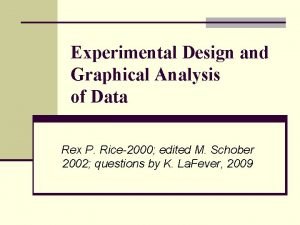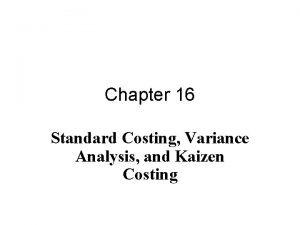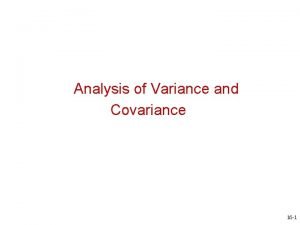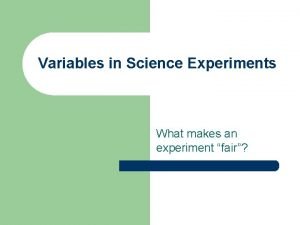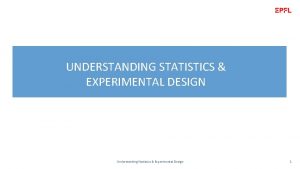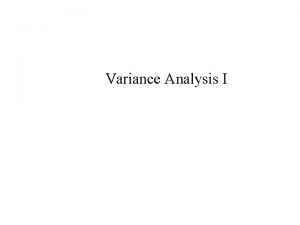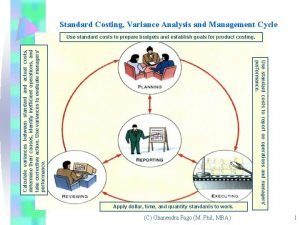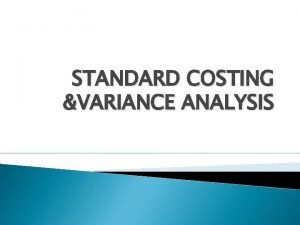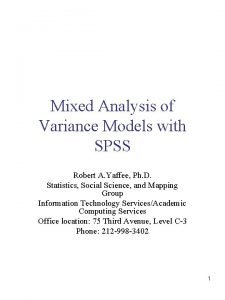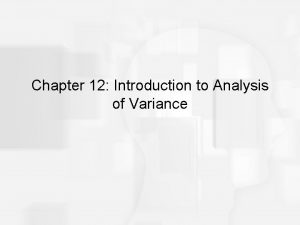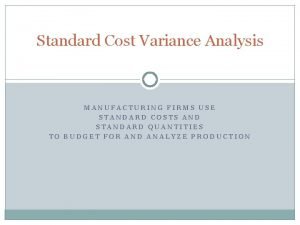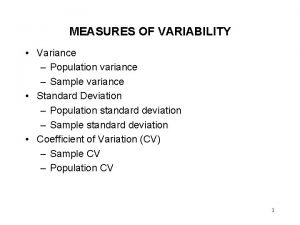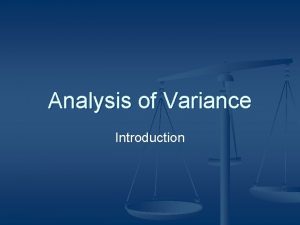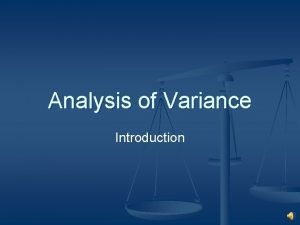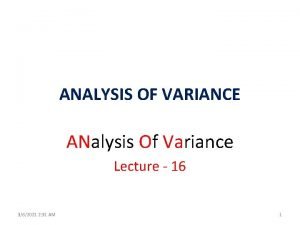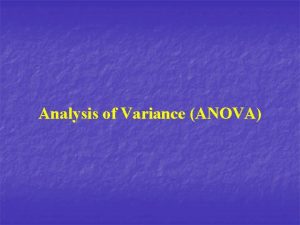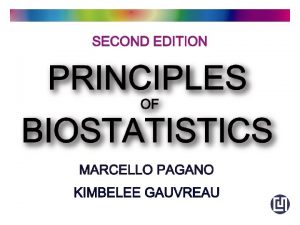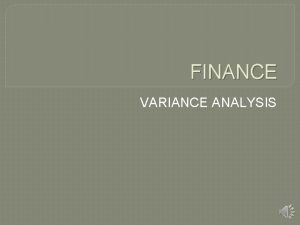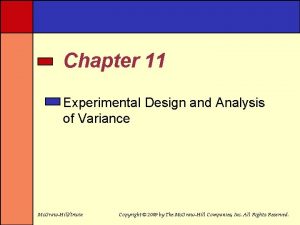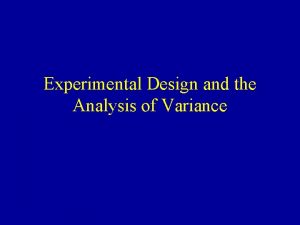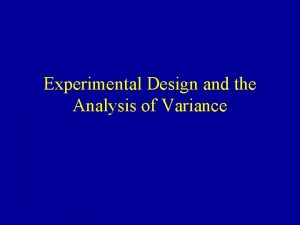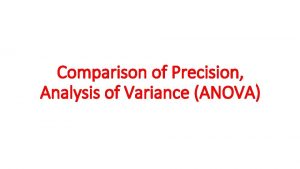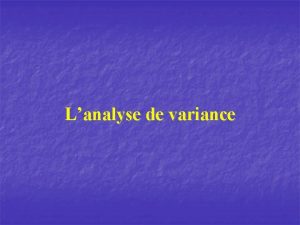Chapter 10 Experimental Design and Analysis of Variance

































- Slides: 33

Chapter 10 Experimental Design and Analysis of Variance Mc. Graw-Hill/Irwin Copyright © 2007 by The Mc. Graw-Hill Companies, Inc. All rights reserved.

Experimental Design and Analysis of Variance 10. 1 10. 2 10. 3 10. 4 Basic Concepts of Experimental Design One-Way Analysis of Variance The Randomized Block Design Two-Way Analysis of Variance 2

Experimental Design #1 • Up until now, have considered only two ways of collecting and comparing data: • Use independent random samples • Use paired (or matched) samples • Often data is collected as the result of an experiment • To systematically study how one or more factors (variables) influence the variable that is being studied 3

Experimental Design #2 • In an experiment, there is strict control over the factors contributing to the experiment • The values or levels of the factors are called treatments • For example, in testing a medical drug, the experimenters decide which participants in the test get the drug and which ones get the placebo, instead of leaving the choice to the subjects • The object is to compare and estimate the effects of different treatments on the response variable 4

Experimental Design #3 • The different treatments are assigned to objects (the test subjects) called experimental units • When a treatment is applied to more than one experimental unit, the treatment is being “replicated” • A designed experiment is an experiment where the analyst controls which treatments used and how they are applied to the experimental units 5

Experimental Design #4 • In a completely randomized experimental design, independent random samples are assigned to each of the treatments • For example, suppose three experimental units are to be assigned to five treatments • For completely randomized experimental design randomly pick three experimental units for one treatment, randomly pick three different experimental units from those remaining for the next treatment, and so on 6

Experimental Design #5 • Once the experimental units are assigned and the experiment is performed, a value of the response variable is observed for each experimental unit • Obtain a sample of values for the response variable for each treatment 7

Experimental Design #6 • In a completely randomized experimental design, it is presumed that each sample is a random sample from the population of all possible values of the response variable • That could possibly be observed when using the specific treatment • The samples are independent of each other • Reasonable because the completely randomized design ensures that each sample results from different measurements being taken on different experimental units • Can also say that an independent samples experiment is being performed 8

One-Way Analysis of Variance • Want to study the effects of all p treatments on a response variable • For each treatment, find the mean and standard deviation of all possible values of the response variable when using that treatment • For treatment i, find treatment mean mi • One-way analysis of variance estimates and compares the effects of the different treatments on the response variable • By estimating and comparing the treatment means m 1, m 2, …, mp • One-way analysis of variance, or one-way ANOVA 9

ANOVA Notation • ni denotes the size of the sample randomly selected for treatment i • xij is the jth value of the response variable using treatment i • xi is average of the sample of ni values for treatment i • xi is the point estimate of the treatment mean mi • si is the standard deviation of the sample of ni values for treatment i • si is the point estimate for the treatment (population) standard deviation si 10

One-Way ANOVA Assumptions • Completely randomized experimental design • Assume that a sample has been selected randomly for each of the p treatments on the response variable by using a completely randomized experimental design • Constant variance • The p populations of values of the response variable (associated with the p treatments) all have the same variance 11

One-Way ANOVA Assumptions Continued • Normality • The p populations of values of the response variable all have normal distributions • Independence • The samples of experimental units are randomly selected, independent samples 12

Testing for Significant Differences Between Treatment Means • Are there any statistically significant differences between the sample (treatment) means? • The null hypothesis is that the mean of all p treatments are the same • H 0: m 1 = m 2 = … = m p • The alternative is that some (or all, but at least two) of the p treatments have different effects on the mean response • Ha: at least two of m 1, m 2 , …, mp differ 13

Testing for Significant Differences Between Treatment Means Continued • Compare the between-treatment variability to the within-treatment variability • Between-treatment variability is the variability of the sample means, sample to sample • Within-treatment variability is the variability of the treatments (that is, the values) within each sample 14

Partitioning the Total Variability in the Response Total Variability = Between Treatment Variability + Within Treatment Variability Total Sum of Squares = Treatment Sum + of Squares SSTO = SST + Error Sum of Squares SSE 15

Mean Squares • The treatment mean-squares is • The error mean-squares is 16

F Test for Difference Between Treatment Means • Suppose that we want to compare p treatment means • The null hypothesis is that all treatment means are the same: • H 0: m 1 = m 2 = … = m p • The alternative hypothesis is that they are not all the same: • Ha: at least two of m 1, m 2 , …, mp differ 17

F Test for Difference Between Treatment Means #2 • Define the F statistic: • The p-value is the area under the F curve to the right of F, where the F curve has p – 1 numerator and n – p denominator degrees of freedom 18

F Test for Difference Between Treatment Means #3 Reject H 0 in favor of Ha at the level of significance if F > F , or if p-value < F is based on p – 1 numerator and n – p denominator degrees of freedom 19

Pairwise Comparisons, Individual Intervals Individual 100(1 - a)% confidence interval for mi – mh: t /2 is based on n – p degrees of freedom 20

Pairwise Comparisons, Simultaneous Intervals Tukey simultaneous 100(1 - )% confidence interval for mi – mh: q is the upper percentage point of the studentized range for p and (n – p) from Table A. 9 m denotes common sample size 21

The Randomized Block Design • A randomized block design compares p treatments (for example, production methods) on each of b blocks (or experimental units or sets of units; for example, machine operators) • Each block is used exactly once to measure the effect of each and every treatment • The order in which each treatment is assigned to a block should be random • A generalization of the paired difference design, this design controls for variability in experimental units by comparing each treatment on the same (not independent) experimental units • Differences in the treatments are not hidden by differences in the experimental units (the blocks) 22

Randomized Block Design Define: xij = the value of the response variable when block j uses treatment i xi • = the mean of the b response variable observed when using treatment i = the treatment i mean x • j = the mean of the p values of the response variable when using block j = the block j mean x = the mean of all the b • p values of the response variable observed in the experiment = the overall mean 23

The ANOVA Table, Randomized Blocks Source Degrees of Freedom Sum of Squares Mean Squares F Statistic Treatments p-1 SST MST = SST p-1 F(trt) = MST MSE Blocks b-1 SSB MSB = SSB b-1 F(blk) = MSB MSE Error (p-1) (b-1) SSE MSE = Total (p b)-1 SSTO SSE (p-1)(b-1) where SSTO = SST + SSB + SSE 24

Sum of Squares • SST measures the amount of between-treatment variability • SSB measures the amount of variability due to the blocks • SSTO measures the total amount of variability • SSE measures the amount of the variability due to error SSE = SSTO – SST – SSB 25

F Test for Treatment Effects H 0: No difference between treatment effects Ha: At least two treatment effects differ Reject H 0 if F > F or p-value < F is based on p-1 numerator and (p-1) (b-1) denominator degrees of freedom 26

F Test for Block Effects H 0: No difference between block effects Ha: At least two block effects differ Reject H 0 if F > F or p-value < F is based on b-1 numerator and (p-1) (b-1) denominator degrees of freedom 27

Estimation of Treatment Differences Under Randomized Blocks, Individual Intervals Individual 100(1 - a)% confidence interval for mi - mh t /2 is based on (p-1)(b-1) degrees of freedom 28

Estimation of Treatment Differences Under Randomized Blocks, Simultaneous Intervals Tukey simultaneous 100(1 - )% confidence interval for mi - mh q is the upper percentage point of the studentized range for p and (p-1)(b-1) from Table A. 9 29

Two-Way Analysis of Variance A two factorial design compares the mean response for a levels of factor 1 (for example, display height) and each of b levels of factor 2 ( for example, display width. ) A treatment is a combination of a level of factor 1 and a level of factor 2 Factor 1 1 1 2. . . a Factor 2 2 3… b xijk = response for the kth experimental unit (k=1, …, m) assigned to the ith level of Factor 1 and the jth level of Factor 2 30

Two-Way ANOVA Table Source Degrees of Freedom Sum of Squares Mean Squares F Statistic Factor 1 a-1 SS(1) MS(1) = SS(1) a-1 F(1) = MS(1) MSE Factor 1 b-1 SS(2) MS(2) = SS(2) b-1 F(2) = MS(2) MSE Interaction (a-1)(b-1) SS(int) MS(int) = SS(int) F(int) = MS(int) (a-1)(b-1) MSE Error ab(m-1) SSE MSE = Total abm-1 SSTO SSE ab(m-1) 31

Estimation of Treatment Differences Under Two-Way ANOVA, Factor 1 Individual 100(1 - )% confidence interval for mi - mi’ t /2 is based on ab(m-1) degrees of freedom Tukey simultaneous 100(1 - )% confidence interval for mi - mi’ q is the upper percentage point of the studentized range for a and ab(m-1) from Table A. 9 32

Estimation of Treatment Differences Under Two-Way ANOVA, Factor 2 Individual 100(1 - a)% confidence interval for m j - m j’ t /2 is based on ab(m-1) degrees of freedom Tukey simultaneous 100(1 - )% confidence interval for m j - m j’ q is the upper percentage point of the studentized range for b and ab(m-1) from Table A. 9 33
 Experimental vs nonexperimental research
Experimental vs nonexperimental research Variance analysis meaning
Variance analysis meaning Experimental vs non experimental
Experimental vs non experimental Descriptive vs correlational vs experimental research
Descriptive vs correlational vs experimental research Experimental vs non experimental research
Experimental vs non experimental research Experimental vs non experimental
Experimental vs non experimental How to linearize a side opening parabola
How to linearize a side opening parabola Flexed budget formula
Flexed budget formula Multivariate analysis of variance and covariance
Multivariate analysis of variance and covariance The formula for usage variance is (aq - sq) * sp.
The formula for usage variance is (aq - sq) * sp. Flexible budget variance example
Flexible budget variance example Analysis of variance and covariance
Analysis of variance and covariance Standard costing and variance analysis
Standard costing and variance analysis What is an independent variable in an experiment
What is an independent variable in an experiment Experimental design independent and dependent variables
Experimental design independent and dependent variables Statistics
Statistics Ethical consideration in experimental research sample
Ethical consideration in experimental research sample Experimental design questions and answers
Experimental design questions and answers Inputs and outputs of system design
Inputs and outputs of system design Budget variance analysis
Budget variance analysis Variance analysis cycle
Variance analysis cycle Tr
Tr Multiple analysis of variance
Multiple analysis of variance Direct materials variance
Direct materials variance Job cost variance
Job cost variance Mixed analysis of variance
Mixed analysis of variance Variance analysis in nursing
Variance analysis in nursing Introduction to analysis of variance
Introduction to analysis of variance Kaizen emfasis
Kaizen emfasis Manufacturing cost variance analysis
Manufacturing cost variance analysis Variance analysis
Variance analysis Mancova
Mancova Solomon four group design
Solomon four group design Quasi experimental design example
Quasi experimental design example






